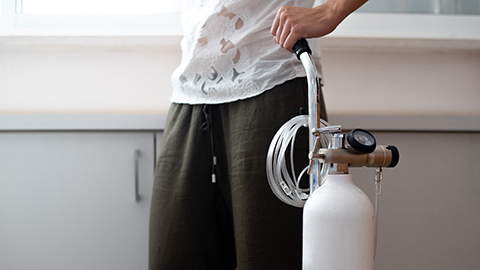
A client with reduced heart function and a portable oxygen tank books a 90-minute massage. A doctor’s note has been obtained, but the massage therapist hasn’t seen it.
What is going on with this person’s heart? And can they tolerate 90 minutes on a massage table? As always, it depends. Listen in to find out what it depends on.


Anatomy Trains is a global leader in online anatomy educationand alsoprovides in-classroom certification programs forstructuralintegration in the US, Canada, Australia,Europe, Japan, and China, as well as fresh-tissue cadaverdissectionlabs and weekend courses. The work of Anatomy Trains originated with founder Tom Myers, who mapped the human body into 13 myofascial meridians in his original book, currently in itsfourthedition and translated into 12 languages. The principles of Anatomy Trains are used by osteopaths, physical therapists, bodyworkers, massage therapists, personal trainers, yoga, Pilates,Gyrotonics, and other body-minded manual therapists and movement professionals. Anatomy Trains inspires these practitioners to work with holisticanatomy in treating system-wide patterns to provide improved client outcomes in terms of structure and function.
Website:anatomytrains.com
Email:info@anatomytrains.com
Facebook:facebook.com/AnatomyTrains
Instagram: www.instagram.com/anatomytrainsofficial
YouTube:https://www.youtube.com/channel/UC2g6TOEFrX4b-CigknssKHA
0:00:01.2 Ruth Werner: Hey, I Have a Client Who listeners, did you know I have a growing library of NCB approved one-hour online self-paced continuing education courses that you can do any time, anywhere. Well, now you know, current classes include what's next, covid 19 updates from massage therapists and a massage therapists, Introduction to pharmacology part one, and brand new. A massage therapist's Introduction to pharmacology part two, classes are $20 each, and they confer one hour of continuing education credit. Wanna know more? Visit my website at ruthwerner.com and check it out. Be sure to sign up for my mailing list so you'll never miss a new class.
0:00:47.6 Speaker 2: Anatomy trains is delighted to invite you to our in-person fascial dissection workshop, May 30th through June 3rd, 2022. We're excited to be back in the lab with Anatomy Trains, author Tom Myers and master dissector Todd Garcia in Todd's laboratory of anatomical enlightenment in Boulder, Colorado. Join students from around the world and from all types of manual movement and fitness professions to explore the real human form, not the images you get from books. Visit anatomytrains.com for details.
0:01:33.5 RW: Hi, and welcome to I Have a Client Who pathology conversations with Ruth Werner, the podcast where I will discuss your real life stories about clients with conditions that are perplexing or confusing. I'm Ruth Werner, author of a massage therapist Guide to pathology, and I have spent decades studying, writing about and teaching about where massage therapy intersects with diseases and conditions that might limit our client's health. We almost always have something good to offer, even with our most challenged clients, but we need to figure out a way to do that safely, effectively and within our scope of practice, and sometimes as we have all learned... That is harder than it looks.
0:02:20.4 RW: Today's episode comes from a massage therapist who shared their concerns about working with a client who appears to be very medically complicated, and here's what they had to say. I have a client that came in a few weeks ago with a lot of health issues, the one that concerned me most is that she stated her heart is at 50%, she also came in with an oxygen tank, I asked that she please get a doctor's note before the massage, it's also 90 minutes, she's now back on my schedule, I haven't seen her doctor's note on file, but my job says they have it. I've been a therapist for 12 years and never came across a client with all these health issues, so I'm a bit stressed. I mean is it okay to massage a client whose heart is at 50% and comes with an oxygen tank and will she be okay on 90 minutes. Good questions. I have so much to say about this one. And also just a little bit of a teaser. I am right now working on a project about doctor's notes, but it won't be ready until I think fall of 2022 at the soonest.
0:03:25.0 RW: But this story and the completely legitimate concerns of the massage therapist who shares it points out our ongoing need to evaluate both our work and our relationships with other health care providers. So just to start us off, we already know that we don't have a complete picture here, we have a client with quote a lot of health issues, unquote and her quote heart is at 50%. Unquote. I'm gonna guess that this means her heart is only working at 50% of normal capacity, and she came in with an oxygen tank, that's not surprising, and it does give us a hint about what's going on with her heart, and I'll get back to that in a minute, because after all, this is a pathology podcast, we don't know about any other signs of frailty, I would like to know this client's age and what her ankles look like, and if her heart issues are related to something else, or if it is a free-standing problem, she may have a history of other cardiovascular events as part of her heart disease, or maybe a lung problem like COPD, or a history of embolism or maybe all of those, and she's probably taking a slew of medications too. All of those issues can inform choices about massage therapy, not necessarily if to massage, but how to massage.
0:04:42.6 RW: Our contributor says, I asked that she get a doctor's note before the massage, and now her workplace says they have that note, but the massage therapist hasn't seen it, and that right there is why doctor's notes don't do what some people think they do. Based on what I saw throughout this thread in a massage therapist Facebook group, this therapist wants a doctor's note to establish that it is safe for this client to receive massage, but... And you might be able to anticipate what I'm going to say next, what is massage? And why is it the doctor's job to know if this massage therapist, the version of massage is safe, or if this massage therapist has the skills to make appropriate accommodations for this client? Once again, it is not the doctor's job to determine the safety of our work or to guide appropriate accommodations. And I could get all kinds of worked up about this whole issue, but I will rein it in for now and let's just turn our attention to this particular client and her needs.
0:05:49.7 RW: So she says her heart is at 50% and she needs to supplement oxygen, we don't know exactly what this 50% refers to, but we can make a guess that it has to do with the strength of her heartbeat and the output of blood into the systemic and pulmonary circuits. This contributor is probably describing a client with heart failure. As I go through this little bit of description, I would love for you to think about this client or maybe one of your own who has some limitation on their cardiovascular function.
0:06:20.2 RW: Imagine what all this means for the safety of your work and how it must inform the way you proceed, have you got someone in mind, get a clear picture of them. Good, here we go. Let me just remind you that our heart is meant to function as two coordinated, but physically separated pumps, the left side of the pump pushes blood from the heart to almost the whole body, and then back again to the heart, and this is the systemic circuit. All that blood from the body is now deoxygenated and it is returned to the heart into the right atrium. Then the right side of the heart pushes that deoxygenated blood to the lungs and back again, this time it returns to the left atrium, and we've just described the pulmonary circuit from here, the blood enters the left ventricle and it starts over in the systemic circuit. So do you remember that kind of figure-8 left heart to the body, to the right heart to the lung, to the left heart to the body, and so on? And that complete figure-8 happens with our entire blood volume about once a minute when the system is healthy.
0:07:34.7 RW: Amazing. Right. Heart failure means that the heart cannot work hard enough to keep up with our needs, this is not the same thing as cardiac arrest when the heart just stops. With heart failure, the heart keeps on working, and we have all kinds of compensatory reactions with hormones and blood pressure, but ultimately that poor heart, it cannot work hard enough. Heart failure can affect just the left side or just the right side, or it can be biventricular heart failure when it affects both. Left-sided heart failure occurs when there's long-term resistance in the systemic circuit, usually we're talking about the aorta or the big arteries, and this would be linked to things like high blood pressure and atherosclerosis, and the heart has to try to push blood through these clogged up tubes. The consequence of left-sided heart failure is that the left ventricle becomes larger but weaker, and the blood that cannot enter the systemic circuit backs up, it backs up and backs up to the lungs, and the lungs end up with lots of slow-moving blood and a pile up of interstitial fluid, and now we have pulmonary edema which can interfere with breathing.
0:08:49.3 RW: If the damage is in the pulmonary circuit, this is usually related to a history of lung problems like maybe COPD or multiple pulmonary emboli or some other systemic disease like lupus. In this situation, the right ventricle becomes enlarged but weak, this is right-sided failure, and the blood and the fluid back up, and they back up, and they back up to the last capillary beds where gravity weighs things down. So that's legs and ankles for people who are ambulatory or the abdominal cavity for people who can't get out of bed, and this is why I'm curious to know about this client's health history with cardiovascular and lung disease, and also about what her ankles look like. Both of these kinds of heart failure can require oxygen supplementation, but I still wanna know what this person's whole body looks like. If the ankles are enlarged, we know that right-sided heart failure is probably part of the picture. People dealing with heart failure may be taking diuretics to help shed excess water and drugs to help manage blood pressure, and these drugs often cause side effects like fatigue and sometimes a chronic cough.
0:10:04.4 RW: The client in our story today has a severely impaired heart, and one of the repercussions is hypoxia, low oxygen levels, what would it be like for this person to get on a massage table, what about getting on that table for 90 minutes? Well, I want you to think about the person you've envisioned who may be struggling with these limitations, and what do you think? Here are some of my thoughts. It might not be comfortable for this person to be flat on a table, she may need a lot of bolstering or even to receive work in a semi-reclined position, if that's possible. Massage that focuses on fluid flow, deep sweeping, effleurage and grippy, squeezy petrissage on the legs and the arms, these might not serve her well since her systems for managing fluid flow are already compromised, if that is the main thrust of this massage therapists work, I would be really concerned about doing that for 90 minutes, that said, if this person's main goals are relaxation and tension reduction petrissage therapists might be able to be helpful.
0:11:14.1 RW: There's a lot we can do with the back, the back of the neck, let's stay away from the carotid artery until we know more about her cardiovascular disease history. We can also work with her scalp and her hands, all the places where relaxing massage can make a big difference without accessing major blood vessels, with the caveat that we have to make adjustments for medication and side effects, especially with positioning, if laying down makes her cough, and with how we finish the massage and help her transition back to full speed, although this client might not be driving.
0:11:49.8 RW: Even so we don't want her to leave our work space without feeling 100% ready. I confess, I think 90 minutes is still a lot of time for someone with this kind of situation. I would definitely support starting with shorter sessions until we know more about how the work is taken in. If this massage therapist has education in lymphatic drainage, they might have some options with that approach. This is not my field of expertise and it's not for dabbling, this really requires substantial advanced education, but none of these accommodations can be specifically guided by a permission slip from a doctor who doesn't know what your skills are, or your strategies or your client's goals for body work. So here is my final word, I encourage this massage therapist to get the information they need to make informed decisions for safe and effective body work. One resource is definitely the client, another one might be the client's health care team, if that team knows what the massage looks like and the massage therapist asks specific questions about their concerns, stay tuned for more on this, I am eager to share my doctor's project with you as soon as it is ready.
0:13:03.5 RW: Hey everybody, thanks for listening to... I Have a Client Who pathology conversations with Ruth Werner. Remember, you can send me your I Have a Client Who stories to... Ihaveaclientwho@abmp.com that's I Have a Client Who all one word, all lowercase at abmp.com. I can't wait to see what you send me and I'll see you next time.